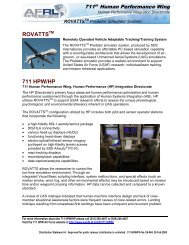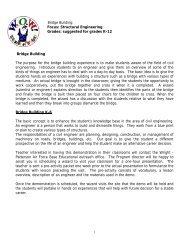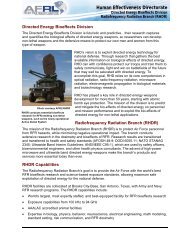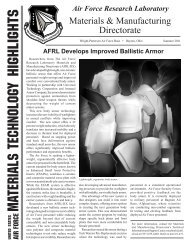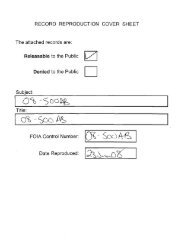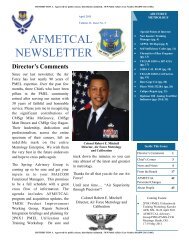TO 00-20-14 30 SEPTEMBER 2011 - Wright-Patterson Air Force Base
TO 00-20-14 30 SEPTEMBER 2011 - Wright-Patterson Air Force Base
TO 00-20-14 30 SEPTEMBER 2011 - Wright-Patterson Air Force Base
- No tags were found...
You also want an ePaper? Increase the reach of your titles
YUMPU automatically turns print PDFs into web optimized ePapers that Google loves.
<strong>TO</strong> <strong>00</strong>-<strong>20</strong>-<strong>14</strong> <strong>30</strong> September <strong>20</strong>119.2.2.2 Generate a PR as follows:a. Annual. All K-stamp holders shall participate in at least two PRs every 12 months. Management shall ensurethese PRs evaluate training and metrology skills appropriate to the technician’s position (e.g., a full calibration ofan item they typically calibrate). The PR may be selected from any status (AWM, ACP, AQR, etc.) as long as itincludes the complete calibration process.b. Targeted. Target any portion of any process (at management discretion). Examination of a process may involveone or more PRs as necessary to collect sufficient data.9.3 NONCONFORMITY (NC).Assigned NC codes are used in trend analysis to determine the most significant problems in the PMEL. By acting on themost significant problems, management improves overall PMEL performance. An item or process may have more thanone NC and each NC shall be assigned a NC code. There are four NC classifications:9.3.1 Critical quality NC (QNC). Deficiencies discovered during QRs and PRs that affect safety, accuracy, reliability ortraceability. Critical QNCs discovered during QRs or PRs may be a negative indicator of laboratory performance.9.3.2 Non-critical QNC. Minor QR quality defects that may be tracked for trend analysis. The AFMETCAL programdoes not require PMELs to report non-critical NCs in their QP activity summary. The category is provided for theconvenience of PMEL management.9.3.3 Critical process NC (PNC). Deficiencies discovered during QRs and PRs that could affect safety, accuracy,reliability or traceability. Analysis of PNCs is used by internal PMEL management to improve PMEL processes and byAFMETCAL to verify the laboratory’s Quality Program effectiveness. Process nonconformities (PNCs) may beidentified during QRs or PRs while observing the technician perform the measurements. Identifying PNCs is a first stepin preventing QR QNCs.9.3.4 Non-critical PNC. Minor process defects that may be tracked for trend analysis. The AFMETCAL program doesnot require PMELs to report non-critical NCs in their QP activity summary. The category is provided for the convenienceof PMEL management.9.4 REVIEW DOCUMENTATION.9.4.1 The results of each review, with or without NCs, shall be recorded in the PAMS QP log or alternate MIS (if PAMSis not available). The following information must be entered: ID Number, Part Number, Serial Number, Work Order/Job Control Number (JCN), Employee Name or Number, Closeout Date, NC Code and RC Code.9.4.2 The documentation for critical NCs shall state whether recall of TMDE was initiated or reasoning for notperforming a recall.9.4.3 Forward the review form per local procedures. PMEL management shall sign or initial all review forms containingcritical NCs and approve/disapprove corrective actions. Retain review documentation for critical NCs.9.5 ROOT CAUSE (RC) ANALYSIS.Accurate RC code classification of identified NCs is essential to effective corrective action/process improvement. Theassigned RC codes are used in trend analysis to determine the most frequent cause of problems in the PMEL. Byeliminating or reducing the most significant cause of problems, management improves overall PMEL qualityperformance. RC codes shall be assigned to all critical NCs. Typically, supervisors, PQA evaluators, and techniciansperform the analysis.9.5.1 As a step in root cause analysis for every critical QNC, the PQA evaluator shall observe the certifying techniciantechnician perform the suspect process without divulging the nonconforming condition. The suspect process shall not bedocumented as a PR.9-2




